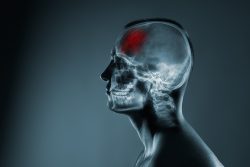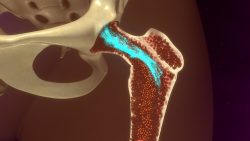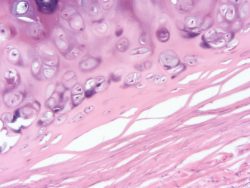Bone Regeneration and Biomaterials
 Craniomaxillofacial (CMF) defects or bone injuries in the skull and face are caused by all kinds of accidents – vehicle, battlefield or sport. To repair these defects a variety of cells need to work with each other making it a difficult process. New research is investigating the reconstruction materials that are being used to discover which would be the most effective for craniomaxillofacial and other bone injuries.
Craniomaxillofacial (CMF) defects or bone injuries in the skull and face are caused by all kinds of accidents – vehicle, battlefield or sport. To repair these defects a variety of cells need to work with each other making it a difficult process. New research is investigating the reconstruction materials that are being used to discover which would be the most effective for craniomaxillofacial and other bone injuries.
More than 2 million surgeries for bone grafts occur worldwide annually. CMF bone grafts are typically irregularly shaped and this is why they are often repaired with the use of regenerative biomaterials. A lab develops scaffold biomaterials from collagen which contain components that are present in bone, such as phosphate and calcium ions and glycosaminoglycans (GAGs) or sugar compounds.
The lab focuses on the development of degradable biomaterials which are called scaffolds for tissue and bone repair. There are a variety of cell types in the environment of the bone that assist in healing including stem cells that will form bone and monocytes that assist with immune response. The current research studied how these scaffold materials will affect the combination of the behavior of the variety of these cells.
The team used collagen biomaterial that included one of 3 different varieties of GAGs that are found in the environment of the bone – heparin, chondroitin–6-sulfate, and chondroitin-4-sulfate. They then researched how these particular GAGs will influence processes which are important to the regeneration of bone such as activation of immune cells, stem cell movement, and endothelial cell activity which are all important in the development of new blood vessels.
The surrounding solution or media was obtained from attaching the stem cells to the scaffolds for 21 days. Stem cells are dynamic molecule factories that can affect other cells in an injury environment. After the collection process, the conditioned solution was added to cultures of endothelial cells from blood vessels. Regeneration of bone is needed for the growth of blood vessels and there have been minimal research on how scaffold materials will affect endothelial cells and how they can improve the repair of bone.
The team followed the growth of the endothelial cells for 6-12 hours. And although heparin is known to be able to effect the formation of blood vessels, to the team’s surprise the media that was generated by stem cells in chondroitin-6-sulfate scaffolds showed the largest amount of the development of blood vessels when compared to the other 2 scaffolds.
Also studied was the media that was conditioned to choose the types of molecules which are known as soluble factors, that help in bone and blood vessel development. The team then added the conditioned media to the monocytes and followed their increase for 21 days to calculate the immune cell types they turned into. They discovered that the numbers and types of soluble factors for each type of scaffold were different. Chondroitin-6-sulfate media made the largest amount of immune cells that assist with an inflammatory response.
The team is now planning to investigate further the stem cell responses. Stem cells are able to signal to monocytes when the body sounds an alarm that there is something wrong. They would like to see if the stem cells that have been grown in the scaffolds in an environment that is inflammatory, will secrete another mix of soluble factors.
The results indicate that soluble factors do play a significant part in the multicellular systems. They have shown that cell responses are different and is dependent on the material used. It is important to understand and know these interactions before moving on to experiments that can be difficult.
It isn’t clear what characteristic of the scaffold materials is adding to the differences in the cell and growth factors which is a challenge the lab plans to take on next. After identifying how the scaffolds influence the cells, they want to blend the cell type varieties to see what happens with this course of action. The team is trying to develop biomaterials that can be used by surgeons to assist in the repair of bone defects. So understanding what the materials do to a variety of types of cells is important.
To view the original scientific study click below:
Glycosaminoglycan content of a mineralized collagen scaffold promotes mesenchymal stem cell secretion of factors to modulate angiogenesis and monocyte differentiation



 New research has shown that a compound produced by intestinal microbes is found in centenarians and protects them from some bacterial infections. The study from the Keio Univ. School of Medicine in Japan along with the Broad Institute of MIT and Harvard found that centenarians exhibited high levels of many species of bacteria. Some of those bacteria produce molecules called secondary bile acids which give the intestines protection from pathogens and support the immune system.
New research has shown that a compound produced by intestinal microbes is found in centenarians and protects them from some bacterial infections. The study from the Keio Univ. School of Medicine in Japan along with the Broad Institute of MIT and Harvard found that centenarians exhibited high levels of many species of bacteria. Some of those bacteria produce molecules called secondary bile acids which give the intestines protection from pathogens and support the immune system. One of the challenges of aging is the ability of skin to regenerate. Older skin does not heal from wounds as well and the cellular and molecular mechanisms are largely unknown. A team from Japan has discovered a mechanism that explains why this can happen, and, therefore can be repaired.
One of the challenges of aging is the ability of skin to regenerate. Older skin does not heal from wounds as well and the cellular and molecular mechanisms are largely unknown. A team from Japan has discovered a mechanism that explains why this can happen, and, therefore can be repaired. New research published by the Australian National University has shown that optimal blood pressure contributes to slower brain aging. You could be at risk even if you have elevated blood pressure that is over 120/80.
New research published by the Australian National University has shown that optimal blood pressure contributes to slower brain aging. You could be at risk even if you have elevated blood pressure that is over 120/80. A new study, the first of its kind, has shown that children who consume more vegetables and fruits have better mental health. The study conducted in the UK studied the link between vegetable and fruit consumption, lunch and breakfast choices and how it affects school children.
A new study, the first of its kind, has shown that children who consume more vegetables and fruits have better mental health. The study conducted in the UK studied the link between vegetable and fruit consumption, lunch and breakfast choices and how it affects school children.  A new UNSW meta-analysis and systematic review has shown that a person can lose about 1.4% of their entire body fat just through strength training. This is similar to how much a person could lose through aerobics or cardio. Even when strength training is done solely on its own, it will still lead to favorable body fat loss without having to go running or dieting.
A new UNSW meta-analysis and systematic review has shown that a person can lose about 1.4% of their entire body fat just through strength training. This is similar to how much a person could lose through aerobics or cardio. Even when strength training is done solely on its own, it will still lead to favorable body fat loss without having to go running or dieting. (TRE) or time restricted eating is a dietary system that works by restricting eating to a specific set of hours. Typically this involves eating during a period of 8 – 10 consecutive hours and then fasting for 14 – 16 hours each day. While TRE is often utilized to lose weight a recent study has shown that TRE confers a variety of additional health benefits. This study also illustrates that some of the benefits may be dependent on age or gender.
(TRE) or time restricted eating is a dietary system that works by restricting eating to a specific set of hours. Typically this involves eating during a period of 8 – 10 consecutive hours and then fasting for 14 – 16 hours each day. While TRE is often utilized to lose weight a recent study has shown that TRE confers a variety of additional health benefits. This study also illustrates that some of the benefits may be dependent on age or gender.  Research has shown that mild physical workouts can increase the link between parts of the brain that are responsible for storage and memory formation. Yoga or Tai Chi helps people remember things such as where they put their keys.
Research has shown that mild physical workouts can increase the link between parts of the brain that are responsible for storage and memory formation. Yoga or Tai Chi helps people remember things such as where they put their keys. New research from the University of Cologne has found that stem cell function reduces as we age due to changes in our epigenome. Because our bones become thinner as we age, fractures and bone diseases occur more often. One reason this may happen may be impaired function of bone-marrow stem cells, which are necessary for bone maintenance integrity.
New research from the University of Cologne has found that stem cell function reduces as we age due to changes in our epigenome. Because our bones become thinner as we age, fractures and bone diseases occur more often. One reason this may happen may be impaired function of bone-marrow stem cells, which are necessary for bone maintenance integrity. Research from the Univ. of Southampton has invented a novel way to use stem cells to generate tissue from human cartilage. This new technique could open up pathways for developing a much needed treatment for cartilage damage in people.
Research from the Univ. of Southampton has invented a novel way to use stem cells to generate tissue from human cartilage. This new technique could open up pathways for developing a much needed treatment for cartilage damage in people.